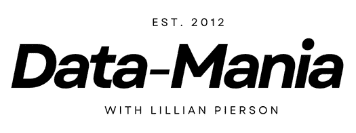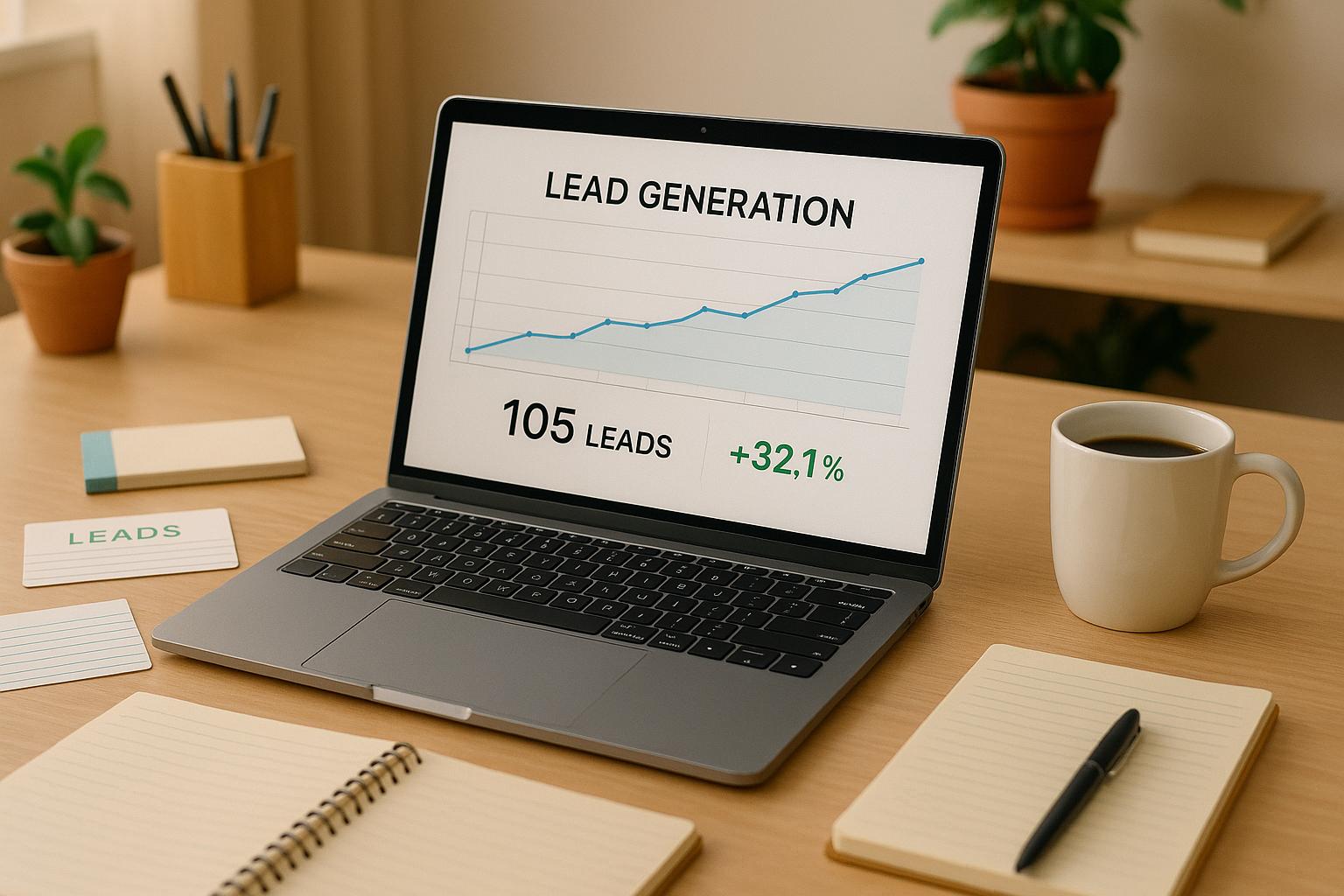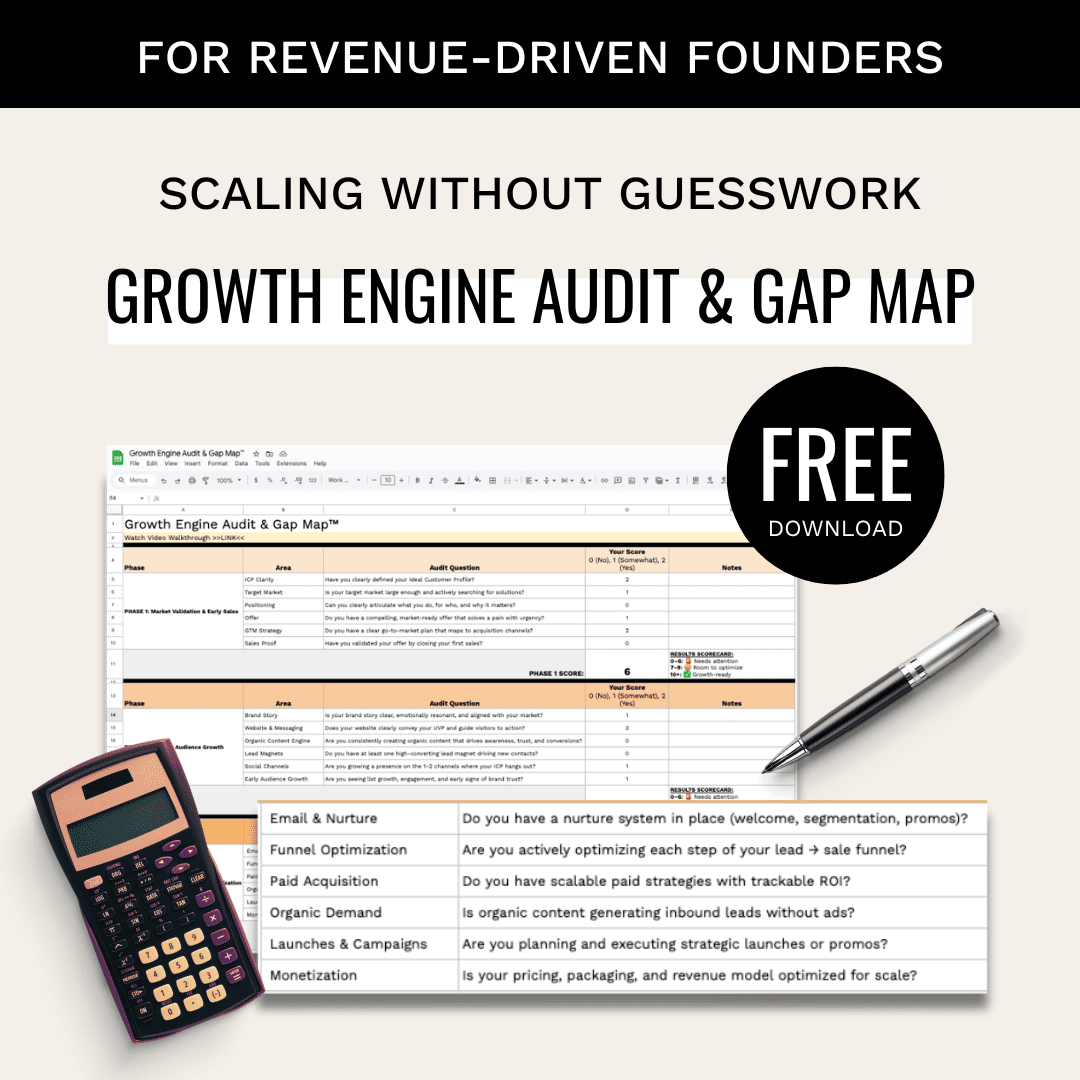If you’re a B2B SaaS founder, getting your first 100 leads can feel impossible. You need users to validate your product, but without a budget, how do you even start?
The Solution in a Nutshell:
Stop waiting for your product to be “perfect.” Lead generation isn’t just about growth – it’s how you discover what your customers actually want. Here’s how to do it without spending big:
- Start with your network: Personalized outreach to people you already know can kickstart conversations and provide early feedback.
- Test with small paid ads: A $500–$1,000 budget can help you figure out which messages and audiences work.
- Sharpen your customer profile: Use data from outreach and ads to refine who you target and how.
- Leverage online communities: Engage in forums, LinkedIn groups, or Reddit to connect with potential customers.
- Create content that helps: Share actionable tips and insights to build trust and attract leads.
Why It Works:
Consistency and focus beat sporadic efforts. By treating lead generation as a system, not a guessing game, you’ll gather the insights needed to refine your product and scale effectively.
Let’s break it down step-by-step.
8 Best Lead Generation Tactics for Software/SaaS companies
Why B2B SaaS Founders Struggle with Early Lead Generation
Getting from a great idea to that first paying customer is no easy feat for B2B SaaS startups. The journey is filled with challenges, many of which can sidetrack even the most promising ventures. Understanding these obstacles is key for founders who want to make the most of their resources and stay on track. Let’s dive into the common pitfalls of early lead generation and why a structured approach is so critical.
Common Early Lead Generation Mistakes
When it comes to generating early leads, founders often fall into four major traps:
- Perfectionist paralysis: Waiting for the product to be "perfect" before starting any marketing efforts. This not only delays valuable feedback but also wastes time that could be spent understanding the market.
- Sporadic execution: Treating lead generation as an occasional task – sending a few cold emails one week, posting on LinkedIn the next – without consistency. This lack of momentum makes it hard to learn what works.
- Spray and pray targeting: Reaching out to a broad audience without a clear ideal customer profile. This scattered approach weakens messaging, reduces response rates, and makes it tough to identify effective strategies.
- One-way messaging: Approaching lead generation as a one-sided broadcast rather than a conversation. This limits the chance to truly understand prospects’ needs and refine the product based on their insights.
Startup Failure Rates Due to Poor Customer Acquisition
These mistakes can have serious consequences. Many early-stage startups fail because they don’t establish a reliable system for acquiring customers. Without consistent outreach, they miss critical market signals, which can derail growth and make it harder to attract investors. A steady flow of leads isn’t just about sales – it’s about gathering the insights needed to steer the company in the right direction.
Using Marketing to Find Product-Market Fit
There’s a common belief that marketing should wait until after product-market fit is established. But this approach creates an unnecessary divide that can slow progress. In reality, marketing – especially lead generation – plays a crucial role in finding and refining product-market fit.
Talking to potential customers early provides invaluable feedback that shapes the product. Many successful B2B SaaS startups treat their early leads as collaborators, learning which features and value propositions resonate most. This allows them to adjust their offerings based on real-world input.
Additionally, since B2B sales cycles can be lengthy, starting lead generation early helps build a pipeline of prospects who might convert down the road. Founders who approach lead generation as ongoing market research not only validate their assumptions but also ensure their product evolves in the right direction.
Up next, we’ll explore the validation funnel framework – a practical solution to these early lead generation challenges.
The Validation Funnel Framework for B2B SaaS Leads
The validation funnel framework is all about testing lead generation strategies through small, focused experiments. By doing this, B2B SaaS companies can ensure their resources are spent on the 7–10 key touchpoints that genuinely connect with their buyers [1]. Instead of pouring money into untested tactics, this three-step approach helps founders figure out what works through measurable, low-risk trials. It minimizes wasted spending, speeds up learning, and establishes a solid foundation for lead generation. Let’s dive into a case study that shows how this framework turned a small lead list into explosive growth.
Case Study: A SaaS Company’s Rapid Growth with the Validation Funnel
A VC-backed SaaS company, starting with no revenue and a cold list of 800 leads, took a systematic approach to lead generation. Armed with just a $1,000 budget for paid traffic and a plan to warm up their network, they achieved 1,100 new users and 200× user growth in a single month, hitting their first revenue milestone within two months [2].
What set them apart was their methodical testing of value propositions and audience segments. They tracked metrics like conversion rates and user engagement, treating every outreach as a chance to learn rather than a one-off attempt. This commitment to experimentation gave them a clear edge over companies that rely on sporadic, unstructured efforts.
Step 1: Start with Your Existing Network
The first step is leveraging your current connections. Instead of blasting the same message to everyone, segment your contacts based on how closely they align with your ideal customer profile. Then, craft personalized messages that reference shared experiences, clearly outline your value proposition, and ask for specific feedback or introductions. The goal? To kickstart conversations that not only provide insights into the market but also spark interest in your solution.
For context, B2B SaaS cold email benchmarks typically show open rates of 21% to 28% and reply rates between 1% and 5%, depending on how personalized the outreach is [1].
Step 2: Test with Small Paid Ad Campaigns
Next, allocate a modest budget – around $500 to $1,000 – to test various value propositions, ad creatives, and audience segments on platforms where your target customers are active. For many B2B SaaS companies, LinkedIn often delivers higher-quality leads, even if it comes at a higher cost per click [1].
These small ad campaigns are not about immediate ROI but about gathering data. Monitor metrics like click-through rates, cost per lead, and conversion rates to see which combinations resonate most with your audience. Once you identify what works, you’ll have actionable insights to refine your messaging and audience targeting further.
Step 3: Sharpen Your Ideal Customer Profile
The final step is analyzing the data from your outreach and ad tests to refine your ideal customer profile. Look at metrics such as lead-to-customer conversion rates and early retention indicators like product activation and repeat engagement [2].
Here are some benchmarks to guide your analysis:
| Validation Metric | Benchmark Range | What It Indicates |
|---|---|---|
| Cold Email Reply Rate | 8–15% | How well your message resonates |
| Paid Ad Conversion Rate | 2–5% | Effectiveness of your value proposition |
| Lead-to-Customer Rate | 10–25% | Strength of your product-market fit |
Your ideal customer profile should combine firmographic details – like industry, company size, and job titles – with insights into customer pain points and buying triggers. Over time, you’ll learn which segments convert most effectively and can adjust your targeting accordingly. Early-stage SaaS companies often face customer acquisition costs ranging from $200 to over $1,000 per customer. Many startups that secure their first 100 qualified leads within 3–6 months usually land their first 10 paying customers in the same period [2].
This three-step process turns lead generation into a structured, data-driven strategy. By starting small, measuring results, and refining based on real-world feedback, founders can confidently scale their efforts while avoiding costly missteps.
sbb-itb-e8c8399
5 Low-Cost Methods to Generate Your First 100 B2B SaaS Leads
You don’t need a big budget to land your first 100 leads. These cost-effective strategies not only keep expenses low but also provide valuable insights to fine-tune your approach. Here are five proven methods that work well for early-stage B2B SaaS companies operating with limited resources.
Cold Email Outreach to Your Target Customers
Start by defining your ideal customer profile (ICP). Focus on a specific group that shares common traits – this makes your outreach more relevant and effective.
The next step is finding verified email addresses. There are tools out there that can help you access a database of verified contacts, reducing bounce rates and improving delivery success. Once you have your list, craft short, personalized emails that reference recent company news or address specific challenges your prospects face. Always include a single, clear call-to-action to simplify the next steps.
Track your results meticulously. Monitor metrics like open rates, reply rates, and conversions. Experiment with different subject lines, email lengths, and CTAs to see what resonates best. Over time, this data-driven approach will help you refine your outreach for consistent results.
Finding Prospects in Online Communities
Online communities are another powerful way to connect with potential customers. Platforms like Reddit, LinkedIn groups, Discord servers, and industry-specific forums are filled with discussions where your prospects share challenges and seek solutions.
Focus on providing value first. Instead of pitching your product, offer thoughtful answers, share helpful resources, and show genuine interest in solving problems. This builds trust and positions you as an expert in your field.
Use the platform’s search function to find relevant conversations. Once you’ve contributed meaningfully, follow up privately with personalized advice rather than a sales pitch. These interactions can lead to email signups, which you can nurture into qualified leads. To expand your reach further, consider small-budget paid ads targeting users actively searching for solutions.
Small-Budget Paid Advertising Tests
Paid ads can deliver quick results, even on a tight budget. Platforms like LinkedIn allow precise targeting, making it easier to connect with high-quality B2B leads. Similarly, Google Ads can help you reach prospects already searching for solutions, though success often depends on fine-tuning keywords and landing pages.
Test one variable at a time to gain clear insights. For instance, create separate campaigns for different audience segments but keep the ad creative consistent. Evaluate performance based on metrics like cost per lead and engagement, and adjust your messaging accordingly.
Building an Email List for Future Customers
Lead magnets are a great way to grow your email list. Offer valuable resources – such as reports, templates, or tools – that your target audience can access in exchange for their email address.
Once you’ve captured leads, nurture them with an email sequence that delivers ongoing value. Share industry insights, case studies, and actionable tips to keep your solution top-of-mind. Engage with prospects on social media by offering additional resources, such as newsletters, to those who interact with your content. You can also re-engage dormant leads with targeted reactivation campaigns.
Content marketing is another effective way to attract and convert leads. By combining lead magnets with valuable content, you’ll establish a steady stream of prospects for your email list.
Creating Content to Attract Leads
Content that educates and informs can be a magnet for leads. Share insights on industry trends, customer challenges, and behind-the-scenes updates to position your brand as a trusted resource.
Adopt a "helpful expert" mindset. Instead of promoting your product, focus on sharing actionable tips, strategies, and frameworks. This builds credibility and encourages engagement. When someone comments on or shares your content, follow up thoughtfully to turn these interactions into qualified leads.
Consistency is key. Stick to a regular publishing schedule to build momentum. Over time, track which topics resonate most with your audience and adjust your content strategy to address their needs more effectively.
When to Scale Your Lead Generation Efforts
Knowing when to transition from testing to scaling can make a huge difference in how effectively you grow. Many B2B SaaS founders either jump the gun and scale too early or hesitate too long, missing out on key growth windows. The trick is to recognize specific signs that your lead generation strategy is ready to expand. These signals show that your testing phase has done its job, and it’s time to ramp things up.
3 Signs Your Lead Generation Strategy Is Ready to Scale
Strong Product Validation Through Customer Feedback
One reliable way to measure product-market fit is through user surveys. Ask customers how they’d feel if your product disappeared. If a majority say they’d be very disappointed, it’s a clear sign your product is solving a real problem. This kind of validation often leads to more predictable lead generation, as satisfied users naturally spread the word, boosting referrals and conversion rates.
Steady Customer Engagement
When you see consistent engagement and improved retention, it’s proof that your product is delivering ongoing value. This stability means your leads are more likely to convert and stick around, reducing churn and making scaling efforts more effective.
Paying Customers as Proof of Concept
Landing paying customers is more than just a revenue milestone – it’s evidence that people see enough value in your solution to invest in it. These early customers also help you refine your ideal customer profile, pricing, and sales process. Plus, their testimonials and case studies can become powerful tools to attract and convert future leads.
These three indicators show that your lead generation strategy has moved beyond the experimental phase and is ready for broader application.
Building a Repeatable Lead Generation Process
To scale effectively, you need a process that can be repeated reliably. Start by documenting the steps behind your most successful lead generation channel. Let’s say cold email outreach is working well – record everything: how you research prospects, the email templates you use, follow-up sequences, and how you track conversions. Templates and checklists can help maintain consistency as you increase volume.
Next, test this documented process with others, whether team members or contractors. If they can replicate your results, it’s a sign the system is scalable. Any inconsistencies that pop up during this phase can be fixed before you fully expand. Once the process is solid, evaluate which channels are best suited for scaling.
Lead Generation Channels That Scale Well
Not all lead generation methods grow at the same pace or with the same ease. Here’s a breakdown of what works:
- Cold Outreach: This method scales easily with automation tools and team expansion.
- Content Marketing: While it takes time to build momentum, evergreen content can bring in leads consistently over the long term. It’s a slower burn but pays off with sustained results.
- Paid Advertising: If you need quick results, paid ads are a go-to option. Platforms like LinkedIn and Google Ads allow for rapid scaling, but you’ll need to keep a close eye on your budget and regularly optimize campaigns to avoid overspending.
- Community-Based Prospecting: This approach is great for building trust and relationships but is harder to scale since it relies on personalized interactions. It’s best used alongside other strategies.
Many successful B2B SaaS companies don’t rely on just one channel. Instead, they start by scaling their top-performing strategy and gradually add others to create a diversified, repeatable lead generation process. By combining multiple approaches, you can maximize your reach and ensure long-term growth.
Conclusion: Building Your B2B SaaS Lead Generation System
Generating your first 100 B2B SaaS leads doesn’t require a hefty marketing budget – it calls for a structured, proven approach that focuses on understanding your customers before scaling up. Many founders make the mistake of diving into aggressive scaling without first nailing down their ideal customer profile or fine-tuning their value proposition. This often results in wasted resources, high acquisition costs, and growth that’s anything but sustainable[1].
As discussed earlier, having a documented and repeatable process far outperforms relying on sporadic outreach or one-off tactics. By carefully mapping out the customer journey and tracking every interaction, you create a system that can be refined and expanded over time. This makes it easier to identify what’s working and what needs improvement.
Start with one channel. Instead of spreading your resources thin across multiple lead generation strategies, focus on mastering a single channel that aligns most closely with where your target customers spend their time. Whether it’s cold email campaigns, engaging in niche communities, or running targeted paid ads, going deep on one method is far more effective in the early stages. Once you’ve built a repeatable process that delivers consistent results, you can gradually branch out into additional channels.
After mastering your initial channel, take actionable steps to solidify your process. Define your ideal customer profile with as much detail as possible, craft outreach messages that address specific pain points, and use the needed tools to access verified contact information. Document every part of the process so it can be repeated and improved as you scale.
Keep in mind that B2B buyers typically need 7–10 touchpoints before they’re ready to engage[1]. This persistence, combined with a coordinated multi-channel strategy, sets the stage for more advanced lead generation efforts as your business grows. A disciplined, step-by-step approach ensures long-term success.
Building a reliable lead generation system takes upfront effort but pays off in the long run. By sticking to a clear, data-driven strategy, you’ll create a foundation for scalable growth. Start small, measure everything, and let the data guide your decisions as you work toward achieving those first 100 leads.
FAQs
How can I use my existing network to generate early B2B SaaS leads without coming across as overly sales-driven?
To kickstart early B2B SaaS lead generation through your network without coming off as overly sales-focused, concentrate on fostering trust and offering genuine value. Begin by sending personalized messages that directly address the challenges your contacts might be facing. Instead of diving into a product pitch, share helpful insights, resources, or practical solutions that showcase your expertise and provide real support.
Another effective strategy is engaging in meaningful discussions on platforms like LinkedIn, Reddit, or niche industry forums. By contributing thoughtful advice and joining relevant conversations, you can establish yourself as a knowledgeable and approachable professional. This method not only builds credibility but also encourages potential customers to reach out to you organically, keeping interactions professional yet approachable.
What are effective ways to measure and optimize small-budget paid ad campaigns for B2B SaaS lead generation?
To make the most of small-budget paid ad campaigns, focus on critical metrics such as cost per lead (CPL), conversion rate, and return on ad spend (ROAS). These numbers reveal how efficiently your campaigns are performing and highlight areas that need fine-tuning.
Incorporate A/B testing to explore variations in ad copy, audience targeting, and landing pages. This helps you uncover what resonates best with your audience. Keep an eye on early indicators like click-through rates (CTR) and engagement levels to quickly gauge how relevant your ads are and make adjustments as needed.
Establish clear performance benchmarks and consistently review your campaign data. By analyzing the results and refining your strategy, you can stretch your budget further and ensure your ads generate meaningful leads.
How can I tell if my lead generation strategy is ready to scale, and what steps should I follow to expand effectively?
To determine if your lead generation strategy is ready to scale, pay attention to a few key milestones. For instance, achieving a 40% positive response rate in product-market fit (PMF) surveys, observing flattened retention curves, and securing at least 10 paying customers are strong indicators that your strategy is on solid ground and primed for growth.
Once you’ve hit these benchmarks, the next step is to build a systematic and repeatable process for generating leads. Clearly document the details of your channels, messaging, and outreach methods. When scaling, take it step by step – expand to one channel at a time. Keep a close eye on critical metrics like conversion rates, customer retention, and customer acquisition cost (CAC) to ensure your growth remains sustainable. This careful, data-driven approach reduces risks while setting you up for long-term success.
Related Blog Posts
- Marketing Tech Stack Checklist for Early-Stage Startups
- How to Build a SaaS Marketing Strategy from Scratch
- 5 Best Practices for B2B Marketing Automation Success
- Product-Led Content Strategy: Steps for SaaS Growth




